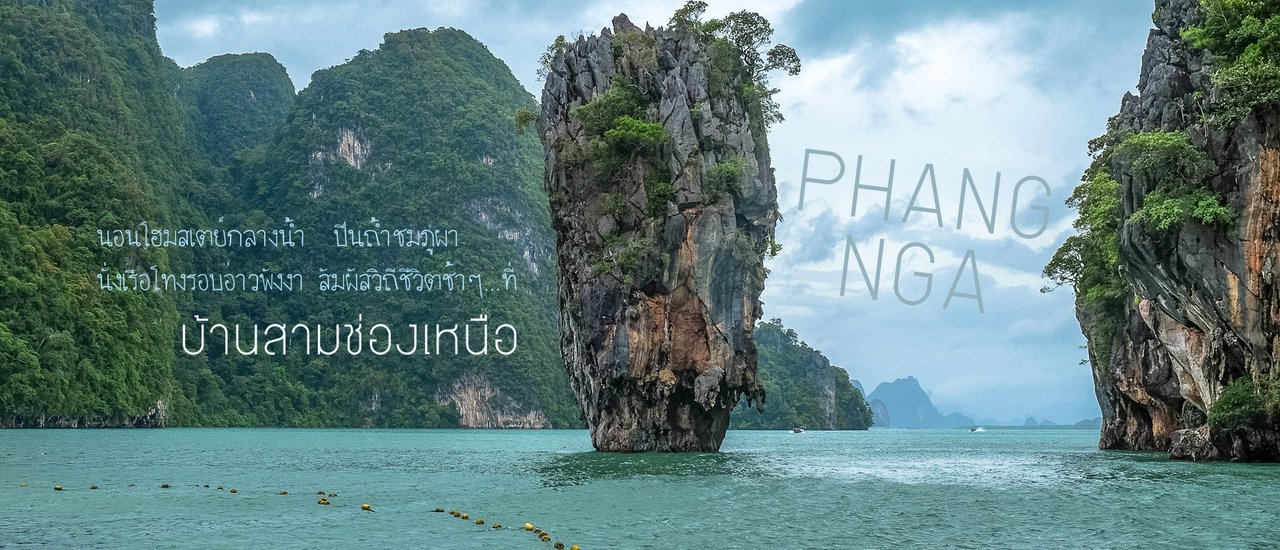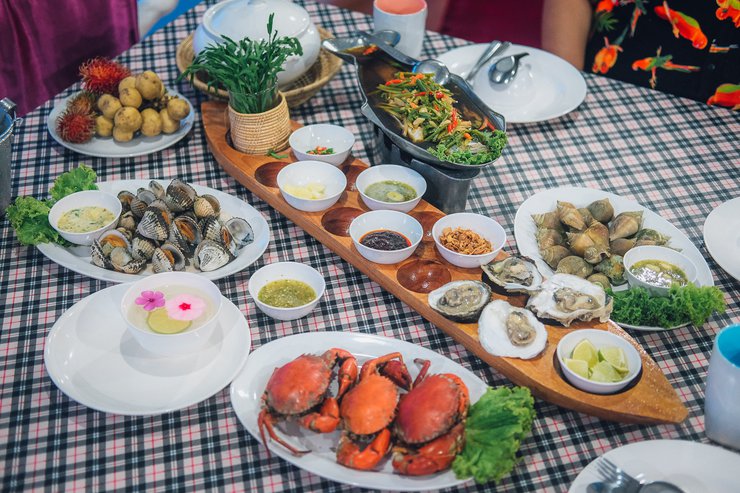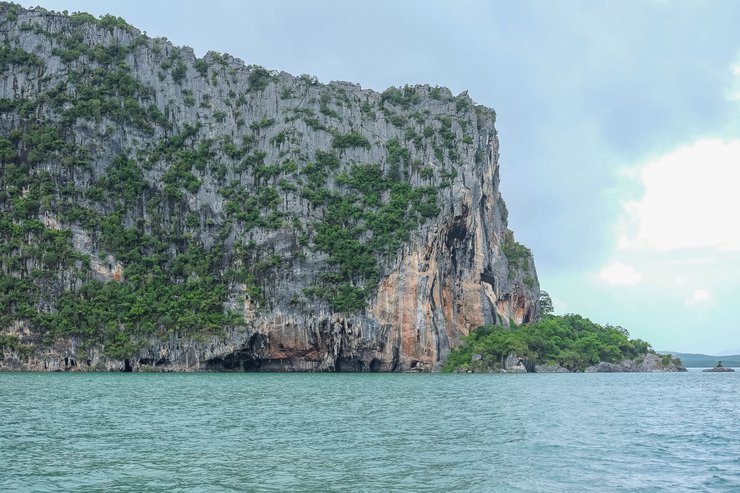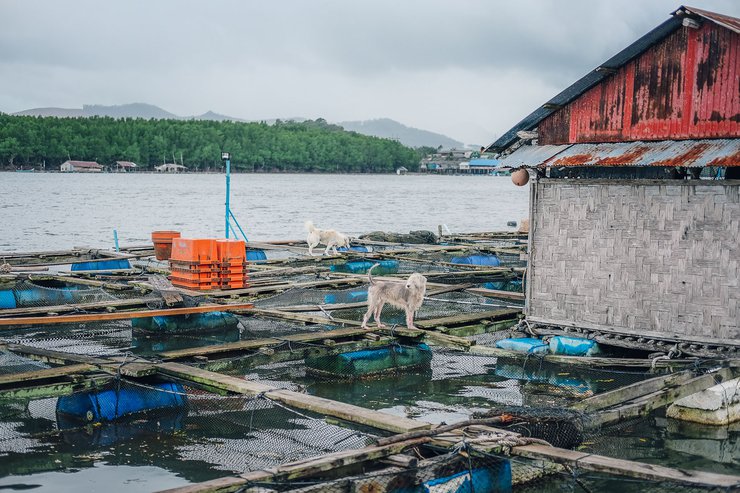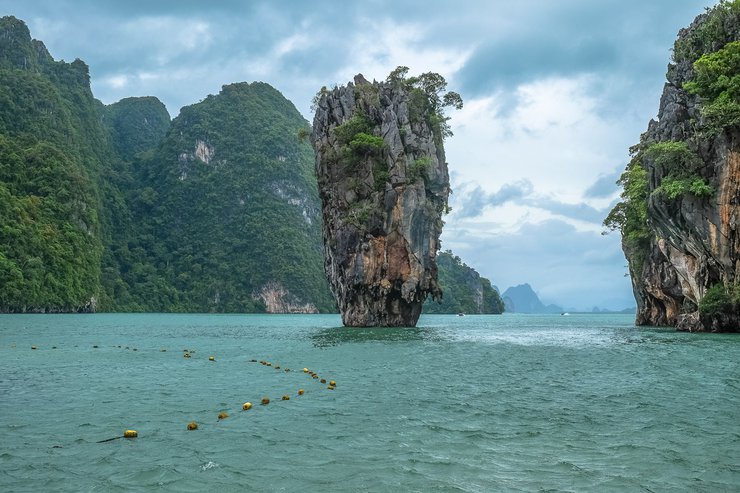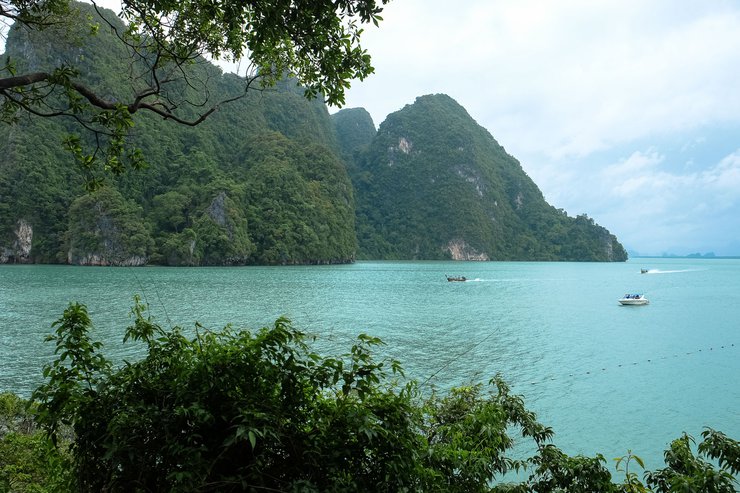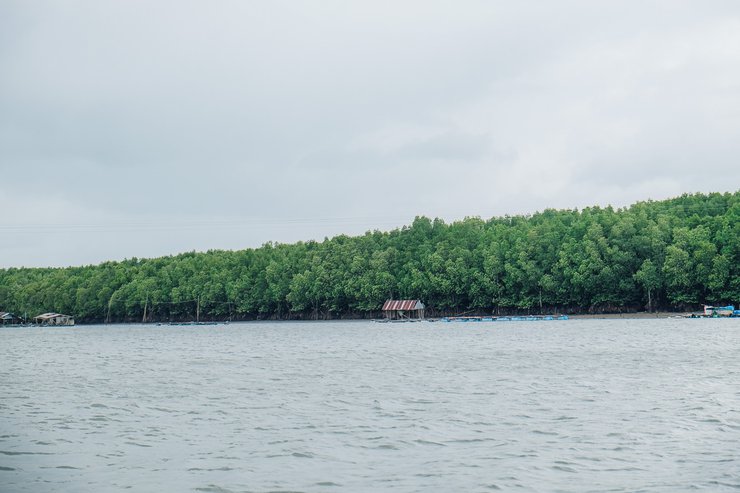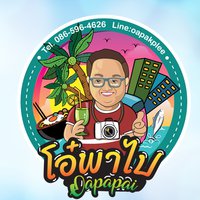In our childhood days of playing word puzzle games, this question would have been familiar.
"Which province do elephants fear the most?"
"Crash-bang-wallop!"
Embark on a captivating journey to a province brimming with natural wonders. Discover pristine emerald-hued waters, an archipelago of idyllic islands, awe-inspiring limestone karst formations, and enigmatic caves adorned with stalactites and stalagmites. Immerse yourself in the authentic local lifestyle at Baan Sam Chong Nuea, a charming OTOP community nestled amidst the mangroves. Experience the simplicity and allure of their way of life.

Day 1
Early Morning Journey to Baan Sam Chong
On the morning of August 9th, we embarked on a journey with friends in a rented car from Krabi province. The 113-kilometer drive from Krabi to Baan Sam Chong was a scenic one, with limestone mountains interspersed with tall and short trees lining both sides of the road, living up to the province's nickname, "Beautiful City in the Valley."
After about an hour and a half, we reached the Baan Sam Chong intersection. Turning left following the sign for Baan Sam Chong Nuea, we found ourselves on a small road shaded by the lush greenery of the mangrove forest. At the end of the road, a giant crab and oyster sculpture stood prominently alongside the words "This is Sam Chong."
We contacted Mr. Surat Sumalee, the village headman of Baan Sam Chong Nuea and the overseer of the community tourism project. Soon, Mr. Surat arrived in a long-tailed boat, the journey taking only 5 minutes from the village. He took us on a kayak tour of the mangrove ecosystem before entering the village. The mangrove forests of Phang Nga province are renowned for being the largest and most fertile in Thailand.

As we sailed through the gentle drizzle, the serene atmosphere was punctuated by the receding tide, revealing the intricate root systems of the mangrove trees. The diverse flora included narrow-leaved and broad-leaved mangroves, white mangroves, red-flowered mangroves, and local plants. Our local guide, who doubled as our boatman, pointed out tiny snails clinging to the mangrove roots, along with the fruits and shells of the Barringtonia and mangrove trees, whose bark is used for dyeing tie-dye fabrics.
Mangrove forests serve as a haven for animals, humans, and a nursery for various aquatic creatures. They provide sustenance for trees, aquatic animals, and raw materials for construction. For instance, unused mangrove wood is used to build houses and other village structures.

Villagers recounted their experiences during the tsunami that devastated several southern provinces. Fortunately, the village of Sam Chong Nuea remained unscathed due to its location on the opposite side of the island from the tsunami's impact. The village's mangrove forests also served as a natural barrier, mitigating the force of the waves.
The Balance of Nature: A Tsunami's Paradox
The devastating power of a tsunami often leads to the question of whether nature truly possesses a sense of balance. While the immediate impact of such an event may seem overwhelmingly destructive, a closer examination reveals a more nuanced perspective.
The very forces that unleash the fury of a tsunami can also be seen as safeguards against its full potential. Coastal ecosystems, such as mangrove forests and coral reefs, act as natural buffers, mitigating the impact of waves and protecting vulnerable communities. These ecosystems, in turn, rely on the periodic disturbances caused by tsunamis to maintain their ecological balance.
Therefore, the notion of "balance" in nature takes on a more complex meaning. It is not a static equilibrium, but rather a dynamic interplay of forces, where destruction and creation coexist. The aftermath of a tsunami, while tragic, often paves the way for renewal and regeneration.
This understanding challenges the simplistic view of nature as either benevolent or destructive. Instead, it highlights the intricate interconnectedness of natural processes, where even seemingly catastrophic events can play a role in maintaining the overall balance of the ecosystem.

After finishing our boat trip, the villagers drove us back to the pier of "Ban Sam Chan Nuea". This is a fishing village. Ban Sam Chan Nuea was previously called "Thap Nuea", where "Thap" means a temporary residence for fishermen. Later, in 1914, the village's name was changed to Ban Sam Chan Nuea, following the origin of the three canals that flow through the north of the village: Khlong Bang Lam, Khlong Chiang Mai, and Khlong Ta Jor. These canals converge and are called Khlong Sam Chan.

"Baan Sai Raya Homestay 2"
This is the homestay where we will be staying tonight.
'Mada', the friendly Muslim hostess, introduced herself and showed us to our room. As we opened the door, we couldn't help but exclaim "Wow!" because the image we had in mind of a homestay was far from comfortable. But this place was like a 5-star homestay!
The house has a total of 3 bedrooms: 2 for guests and 1 private room for the owner. The bedrooms have air conditioning and fans to choose from, along with soft, soul-sucking mattresses. There is a living room in the middle of the house, a small kitchen, and a balcony with a relaxing atmosphere by the water, perfect for chilling and enjoying the evening breeze.
We talked to Mada about life here and the rules for visiting the Ban Sam Chong Nuea community. Mada said that the villagers are mostly farmers who grow rubber trees, do coastal fishing, or work as tour guides. There is a community shop, a primary school, and a mosque in the center of the village. Children in the village study until grade 6 and then continue their secondary education in the city.
Most people in the village are Muslim. Mada asks guests to dress modestly, allowing shorts but not too short, and requests that they avoid wearing bikinis or revealing swimwear as it is considered inappropriate. Additionally, alcohol is prohibited on the island.

Adults invited us to have lunch at "Ping Kan Halal Food", a restaurant owned by Mr. Surat. This restaurant is a true Muslim community seafood restaurant, incorporating fresh, high-quality ingredients from the sea, including shrimp, shellfish, crab, fish, and squid, delivered directly to the kitchen by fishermen every day. It is a renowned restaurant that anyone visiting Phang Nga should try.

After finishing our meal, we went for a walk to enjoy the atmosphere around the village. It was quiet and peaceful, with a simple charm. Groups of children played happily, and everyone we passed smiled warmly at us.
The provided text is empty. Please provide the text you want me to translate.

In the afternoon, we visited the production of "kapi klui," a famous shrimp paste from Baan Sam Chong Nuea. This paste is made from "kui" shrimp, which are small, transparent crustaceans about 1.5 centimeters long. They have thin, soft shells and live in groups along the seashore and canals in mangrove forests, in water depths ranging from shin-deep to chest-deep.

Traditional Shrimp Paste Production in Southern Thailand
Shrimp paste, a staple condiment in Southeast Asian cuisine, is traditionally produced in southern Thailand through a meticulous process that involves capturing, processing, and fermenting small shrimp known as "เคย" (krill).
The capture of krill typically involves using blue nylon mesh nets sewn into bag-shaped traps, a method referred to as "รุน" (run). Alternatively, swing nets may be employed depending on the season. The term "รุน" in the southern dialect signifies "pushing" or "propelling forward," aptly describing the action of driving the krill into the nets.
Following capture, the krill undergo a process called "เช" (che), where they are pounded to a pulp. This step prepares them for the subsequent fermentation stage, which transforms them into the flavorful and pungent condiment known as "กะปิเคย" (krill shrimp paste). This traditional method exemplifies the ingenuity of local communities in preserving food through time-tested techniques.

The secret to the deliciousness of kapi khee from Baan Sam Chong Nua lies in the use of pure khee, which gives it a distinct flavor and aroma, unlike mixed kapi.

The sentence is already in English and does not require translation.
Finding Ark Shells at the Ark Shell Bank for Conservation
We took a boat to the same mangrove forest where we paddled our kayaks in the morning. In the evening, when the tide is low, it is the only time to collect ark shells. Children in the community and villagers demonstrated the traditional way of collecting ark shells by using a mud board to slide over the mud, which looked like fun. To collect ark shells, they use their hands to feel under the mud for the shells before putting them in a basket. If they find a small one, they release it back into the wild to continue growing.

Mr. Surat explained that he typically buys small cockle seeds and scatters them in the water to grow naturally. This helps to increase the cockle population. Once the cockles reach maturity, they are harvested for consumption. This approach promotes a sustainable food source for both personal consumption and sale, ensuring a livelihood for the community.

Witness the Giant Sea Catfish Farm
Nestled within the mangrove forests of Baan Sam Chan Nuea, a vibrant community thrives not only on fishing but also on a diverse array of aquaculture ventures, including oyster farms, cockle farms, and various fish farms. Among these, one particular operation stands out: a giant sea catfish farm.

The farm owner told us that these fish are not yet fully grown and are not yet old enough to be sold. However, the catfish we saw were already very large. How big will they be when they are fully grown?

As the sun dipped below the horizon at dusk, casting an ominous shadow over the sky, our boat navigated through the vast expanse of the mangrove forest. The distant hum of multiple engines echoed through the air, indicating that other vessels were also making their way back to shore before the impending rain.
In this tranquil setting, the only concern was the possibility of getting wet, a far cry from the traffic congestion that plagued the bustling city.

This evening, we entrusted our stomachs to "Ping Kan Halal Food" once again. The cockles we gathered this afternoon were waiting for us on the table, along with large fresh oysters and a seafood platter that made our mouths water. Needless to say, the food was delicious. We ate our fill before retiring for the night, preparing for our trip tomorrow.

Day 2
The morning light streamed into the room, signaling the start of a new day. The aroma of delicious food wafted from the kitchen, where Ma Da had prepared shrimp congee for breakfast. We carried our bowls to a table by the water's edge, breathing in the fresh air mingled with the faint scent of the sea. We watched the villagers go about their daily routines, some preparing to set sail for fishing, others heading out to greet tourists.

In the morning, we took a long-tailed boat from Ban Sam Chong Nuea to explore Phang Nga Bay, officially known as Phang Nga Bay National Park. During the boat ride, we observed sedimentary and metamorphic rocks alternating in long stretches, interspersed with occasional limestone outcrops. Due to the susceptibility of limestone to erosion by water dissolution, the islands in Phang Nga Bay exhibit diverse and peculiar shapes, influenced by the weathering and degradation of the rock formations.
When flying from Bangkok to the southern region, we always choose to sit by the window in row A or F to capture the stunning aerial view of Phang Nga Bay. However, the breathtaking scenery is equally captivating whether viewed from above or from a boat.

The boat brought us to the tourist service point, where we had to pay the park maintenance fee ourselves, in addition to the community tour program. For Thai people, adults cost 60 baht, children 30 baht. For foreigners, adults cost 300 baht, children 100 baht. This fee is collected to maintain, preserve and develop the national park.

From the service point, we need to walk another 50 meters to visit Khao Ta Pu and Khao Phing Kan, which are limestone mountains from the Permian period, approximately 295-250 million years ago. Khao Ta Pu has become a world-famous tourist destination, bringing fame to Ao Phang Nga National Park after being featured in some scenes of the James Bond 007 film: The Man with the Golden Gun.
Although we were not yet born at that time, it is guaranteed that these two mountains have been known to Thais and foreigners for many decades. Many people therefore call this island "James Bond Island".

The limestone mountains surrounding the island also have unusual shapes, some with holes and cavities. We enjoyed observing the variety of plants growing scattered among the crevices of the rocks. These plants are unique, some withered and dry, while others appear lush and thriving despite the lack of abundant soil for their growth.


Why is it called "Khao Phing Kan"? We can understand why it's called "Khao Ta Pu" because it looks like a nail. But the first image we saw of "Khao Phing Kan" made the answer clear: because the mountains are leaning against each other! Haha.
The term "เขาพิงกัน" describes a natural phenomenon where a mountain has collapsed, with one side of the resulting crack leaning against the other. This formation is caused by a normal fault cutting through the western side of the island. The fault has sheared off the limestone on the edge of the island, separating it from the main body of the island.
This is a popular pose that many people take photos with. It involves leaning against the rock in the same direction. It is unclear who first came up with this pose, but during my 15-minute observation, I saw everyone queuing up to take photos in this pose.

We continued our journey by boat to the "Diamond Coral Cave." The boat took us through a large opening in the mountain that passed between the two sides of the limestone mountain. Then, our younger brother went up to tie the boat's rope to a small log. Normally, the Diamond Coral Cave is not open to the general public. Only the community of Ban Sam Chong Nuea can bring visitors in.
The ascent to the cave requires climbing a mountain. There are wooden stairs built by the villagers for us to hold onto. This place may not be suitable for the elderly as the path is quite steep. The picture we took is of the easiest path to walk on, as we were unable to take pictures of the steeper sections because one hand was holding onto the wooden railing and the other was climbing the rocks.
The Diamond Cave is a spacious cavern adorned with stunning stalactites and stalagmites illuminated by sunlight. The walls bear inscriptions from ancient times, unfortunately marred by modern graffiti, including English names and crudely drawn hearts. A skylight offers a glimpse of the outside world, casting a soft glow upon the cave floor. For the adventurous, a rope climb leads to the top of the skylight, providing a panoramic view. The ascent resembles scaling a towering slide.

Tie..fasten..tie..dye..
In the afternoon, we returned to the village to make 'tie-dye' cloth. It is a unique process with its own story, whether it is the seams of the fabric, the imperfect but beautiful patterns. The aunt told us that the different colors are also obtained from nature, whether it is roots, bark, stems, fruits, flowers, seeds, leaves, which each tree gives different shades, such as mangrove, black mangrove, and tamarind bark, depending on the properties of each tree.

This passage describes the process of natural dyeing using the bark of the Tabun tree, which produces a deep brown color. The process involves boiling the bark or leaves of the plant to create a concentrated dye solution, known as "nam patao." Cotton fabric is then tied or bound in various ways to create patterns, such as using rubber bands, chopsticks, or string. This traditional tie-dye technique avoids the use of chemicals.

After tying, soak in the bark of the takhun. The longer it is left, the brighter and clearer the color will be. Then wash it again with 3 waters: red lime water, salt water, and clean water until the color stops falling. Then dry it again.

Tie-dyeing is a process of adding value to existing raw materials and preserving local wisdom, following the principles of a sufficiency economy. It creates jobs and generates income for people in the Ban Sam Chan Nuea community, while also enhancing the reputation of the community's products.

A heartfelt thank you to Mr. Suratt Sumalee, the village headman of Baan Sam Chong Nuea community, for taking the time to guide us on this trip. We are also grateful to the villagers, uncles, aunts, and children in the community for their warm welcome and hospitality.
We hope that this journey will inspire many people to find time to relax and reward themselves. We guarantee that if you visit this community, you will undoubtedly fall in love with it.

If you are interested in experiencing a simple and unique community lifestyle, and want to feel the warm smiles and hospitality, you can find more information at
One Night Stay with Locals: Ban Sam Chong Nua Community, Phang Nga
Fanpage : Ban Sam Chong Nua Community-Based Tourism Enterprise
Contact the community: 086-7417949 Mr. Surat Sumalee
There are also 13 other interesting communities to visit throughout Thailand 1nightstaywithlocals.com
Visit my small page at
www.facebook.com/loseoneisway
See you on the next trip, thank you for following. ( ^ / \ ^ )
Supported by


Lose One's Way
Wednesday, February 26, 2025 7:50 PM

